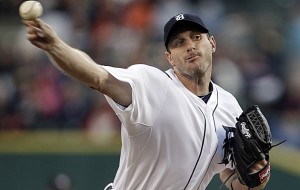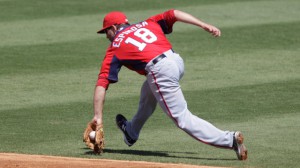Last year we did a quick analysis of all the Qualifying Offer-receiving free agents to see if the system was “working.” (note; from here out I’ll use the abbreviation of QO for Qualifying Offer).
Now that James Shields has signed, there remain no more free agents on the market who received a QO from their former team. Lets take a look at how the qualifying offers affected the markets for those players who got them this off-season.
Here’s a table of the 12 players who received QOs ahead of free-agency (I hope this table is readable once it publishes…)
| Year | Player | Old Team | New Team | Draft Pick Forfeited | Signing Date | Subsequent contract (w/o options) | Money up/down per AAV | Q.O. Screw the player? |
| 2014 | Melky Cabrera | TOR | CWS | 3-81 | 12/15/2014 | 3yr/$42M | -1.3 | Not Really |
| 2014 | Nelson Cruz | BAL | SEA | 1-21 | 12/1/2014 | 4yr/$58M | -0.8 | No |
| 2014 | Michael Cuddyer | COL | NYM | 1-15 | 11/11/2014 | 2yr/$21M | -4.8 | Sort of |
| 2014 | Francisco Liriano | PIT | PIT | none | 12/9/2014 | 3yr/$39M | -2.3 | Sort of |
| 2014 | Russell Martin | PIT | TOR | 1-18 | 11/18/2014 | 5yr/$82M | 1.1 | No |
| 2014 | Victor Martinez | DET | DET | none | 11/14/2014 | 4yr/$68M | 1.7 | No |
| 2014 | Hanley Ramirez | LAD | BOS | 2sup-69 | 11/25/2014 | 4yr/$88M | 6.7 | No |
| 2014 | David Robertson | NYY | CWS | 2-45 | 12/9/2014 | 4yr/$46M | -3.8 | Sort of |
| 2014 | Pablo Sandoval | SFG | BOS | 2-44 | 11/25/2014 | 5yr/$95M | 3.7 | No |
| 2014 | Ervin Santana | ATL | MIN | 2-43 | 12/11/2014 | 4yr/$55M | -1.55 | Not Really |
| 2014 | Max Scherzer | DET | WAS | 1-29 | 1/21/2015 | 7yr/$210M | 14.7 | no |
| 2014 | James Shields | KC | SD | 1-13 | 2/9/2015 | 4yr/$75M | 3.45 | no |
It should be noted that for the third consecutive year, not one player who received a QO accepted it despite its ever increasing value ($15.3M for 2015). Is this “reverse collusion” on the part of the players, not to play the QO game? For the third year, there were players about whom pundits scratched their heads as to why they chose not to take the offer. While not as obvious as in 2013 (when both Stephen Drew and Kendrys Morales vastly over-stated the market for their services and were severely penalized as a result), the fact that especially Michael Cuddyer and David Robertson didn’t take the QO remained puzzling.
So, among the 12 players, who was hurt? In the end, nobody really.
- Half the players got new contracts with AAVs above the QO figure, in some cases significantly above. So they’re not being “hurt” by the system. This list includes Russell Martin, Victor Martinez, Hanley Ramirez, Pablo Sandoval, James Shields and of course our own Max Scherzer.
- Another 3 players (Melky Cabrera, Nelson Cruz and Ervin Santana) signed longer term deals for slightly less than the AAV of $15.3M. I say these guys were “not really” hurt since they guaranteed themselves 3-4 years and in each case nearly or more than $50M of earnings. Each player rightly gambled and guaranteed themselves $50M instead of $15M.
The remaining three players each kind of have extenuating circumstances.
- Michael Cuddyer (inexplicably) signed a 2yr/$21M deal with New York instead of taking a 1yr/$15.3M deal to stay in Colorado. There has to be more to this story; why wouldn’t his agent have advised him of taking the QO and then hoping to get a 1yr/$6M deal the following off-season?? Wouldn’t that have been the better play? Did he want to leave a losing team in Colorado? (If so, why the heck did he go to the Mets??) The Mets even more inexplicably gave up the 15th overall pick to get an 35-yr old corner outfielder who played just 49 games last year due to injuries and who has a combined 3 bWAR in the last two seasons. One can see the nature of the kind of player you can generally get in the mid-first round here. So while Cuddyer’s AAV is way below $15.3M, because he voluntarily signed the Mets contract he only screwed himself 🙂
- Francisco Liriano declined the QO and then re-signed with the same team (Pittsburgh). He got a 3yr deal for $39M. Most pundits would agree that nobody would have given Liriano a $15M/yr longer term deal thanks to his age and injury history, so his taking lesser money AAV but for longer is a smart move for him. Perhaps the QO limited his market, forcing him to go back to Pittsburgh … or perhaps not.
- David Robertson declined the QO but got a 4yr guaranteed deal for $46M … as a reliever. Which is fantastic, considering the volatility of the reliever position in general. So even though his AAV is far less than $15.3M, he made out big time with the amount of guaranteed money.
San Diego gives up the best draft pick (13th overall) to get Shields’ services for four years, but five teams altogether give up first round picks to sign players. Boston gives up its two second round picks to play Ramirez and Sandoval on the right side of their infield for the next four years. A number of very wealthy teams pick up supplemental first round picks (Dodgers, Yankees and Detroit), which (like all FA compensation) kind of seems to defeat the purpose of helping “poorer” teams off-set the loss of marquee players.
Lastly, the order (and pools) for the 2015 draft is now set. A better look is here, showing all the picks gained and lost. Houston has the 2nd, 5th and 37th overall picks, 12 picks in the top 10 rounds and has an astounding $17M of bonus money to acquire players. Washington has just $4.1M to sign its first 10 picks, meaning we’re likely looking at another set of college seniors drafted in rounds 6-10. More on the draft later on.
So, to answer the question of the day; are QOs working? This year they seemed to have worked; you can’t really argue that any player was negatively affected and teams that lost players got compensation picks. You can argue whether the right teams got these picks.
Fyi; the spreadsheet with all this analysis is here: https://docs.google.com/spreadsheets/d/1UEiZzwWarVP3PfCtZeYTVBqC49dmBut21O7UhB17htQ/edit?usp=sharing

